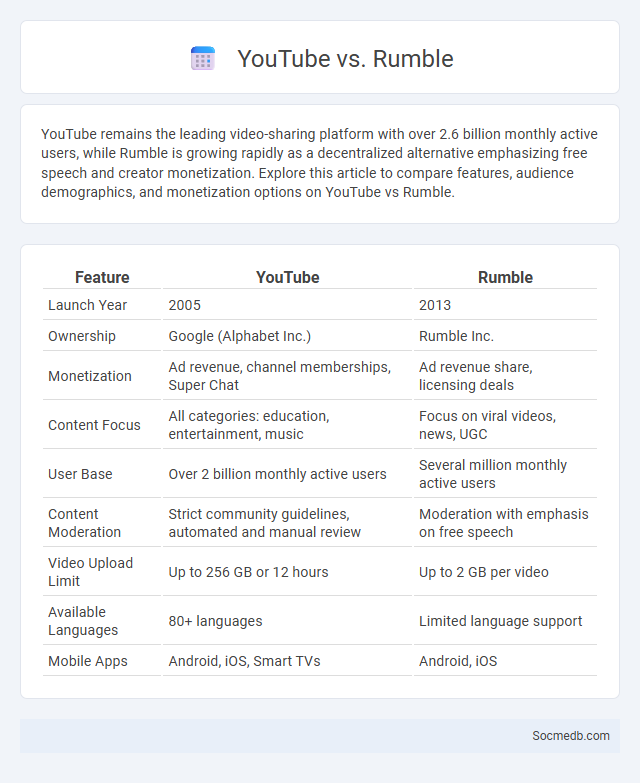
Photo illustration: YouTube vs Rumble
YouTube remains the leading video-sharing platform with over 2.6 billion monthly active users, while Rumble is growing rapidly as a decentralized alternative emphasizing free speech and creator monetization. Explore this article to compare features, audience demographics, and monetization options on YouTube vs Rumble.
Table of Comparison
| Feature | YouTube | Rumble |
|---|---|---|
| Launch Year | 2005 | 2013 |
| Ownership | Google (Alphabet Inc.) | Rumble Inc. |
| Monetization | Ad revenue, channel memberships, Super Chat | Ad revenue share, licensing deals |
| Content Focus | All categories: education, entertainment, music | Focus on viral videos, news, UGC |
| User Base | Over 2 billion monthly active users | Several million monthly active users |
| Content Moderation | Strict community guidelines, automated and manual review | Moderation with emphasis on free speech |
| Video Upload Limit | Up to 256 GB or 12 hours | Up to 2 GB per video |
| Available Languages | 80+ languages | Limited language support |
| Mobile Apps | Android, iOS, Smart TVs | Android, iOS |
Introduction: Comparing YouTube, Rumble, and Content Demonization
YouTube, Rumble, and other platforms differ significantly in content moderation policies and user engagement strategies, impacting how creators share videos and grow audiences. YouTube's sophisticated algorithms and strict community guidelines often lead to content demonetization, affecting creators' revenue streams and exposure. Understanding these platform dynamics helps you choose the best space for content distribution and audience building.
Platform Overviews: YouTube vs Rumble
YouTube dominates social media with over 2 billion monthly active users and a vast array of content categories, offering advanced algorithm-driven recommendations and monetization options for creators. Rumble, a rapidly growing alternative platform, emphasizes free speech and less restrictive content policies, attracting users seeking fewer censorship constraints and tailored monetization opportunities. While YouTube prioritizes mainstream content appeal and advertising revenue, Rumble targets niche audiences focused on independent media and alternative viewpoints.
Content Policies: What Gets Demonized?
Social media content policies often demonize misinformation, hate speech, and explicit material to maintain platform safety and user trust. Your content must avoid violating these guidelines to prevent demonetization, account suspension, or reduced reach. Understanding the nuances of community standards ensures your posts align with platform rules and foster positive engagement.
Monetization Models and Restrictions
Social media platforms offer various monetization models, including ad revenue sharing, sponsored content, subscription services, and in-app purchases to help creators generate income. However, these platforms often impose restrictions such as content guidelines, copyright rules, and payout thresholds that can impact your earnings and account eligibility. Understanding these monetization options and adhering to platform policies is essential for maximizing your social media revenue potential.
Free Speech and Censorship Concerns
Social media platforms face ongoing challenges balancing free speech with content moderation to prevent misinformation and harmful content. Efforts to censor or remove posts often trigger debates about the limits of free expression and potential biases in enforcement policies. Transparency in moderation practices and clear guidelines are crucial to addressing censorship concerns while protecting users' rights to free speech.
Audience Demographics and Reach
Understanding audience demographics is crucial for tailoring social media content that resonates with your target market, including age, gender, location, and interests. Platforms like Facebook, Instagram, LinkedIn, and TikTok offer advanced analytics to track reach and engagement metrics, helping you optimize your content strategy. By leveraging these insights, you can expand your social media reach effectively, ensuring your message connects with the right users.
Algorithm Transparency and Content Discovery
Algorithm transparency enhances user trust by providing clear insights into content ranking and personalization processes on social media platforms. Greater transparency improves content discovery by enabling users to understand why certain posts appear in their feeds, thereby fostering more relevant and diverse interactions. Platforms like Facebook and Twitter are increasingly adopting transparency reports and open-source algorithm initiatives to address user concerns about bias and echo chambers.
Creator Support and Community Guidelines
Creator Support on social media platforms provides resources, monetization options, and educational tools to help you grow your content and engage your audience effectively. Community Guidelines establish clear rules to maintain a safe, respectful environment by addressing issues such as hate speech, harassment, and misinformation. Adhering to these guidelines ensures that your content remains compliant, allowing you to build a trusted and thriving community.
Case Studies: High-Profile Demonization Incidents
High-profile demonization incidents on social media platforms reveal patterns of misinformation, rapid virality, and polarized public responses, as seen in cases like the Gamergate controversy and the Covington Catholic incident. These events highlight the amplification of targeted harassment and character assassination through coordinated campaigns, often fueled by algorithmic biases favoring sensational content. Analysis of these case studies underscores the urgent need for improved content moderation policies and transparency in platform governance to mitigate reputational damage and social division.
Conclusion: Choosing the Right Platform for Creators
Selecting the right social media platform is crucial for creators aiming to maximize reach and engagement. Each platform offers unique tools, audiences, and content styles, so understanding your niche and target demographic will guide your decision effectively. By aligning your creative goals with the platform's strengths, you can optimize your growth and connect meaningfully with your audience.
 socmedb.com
socmedb.com